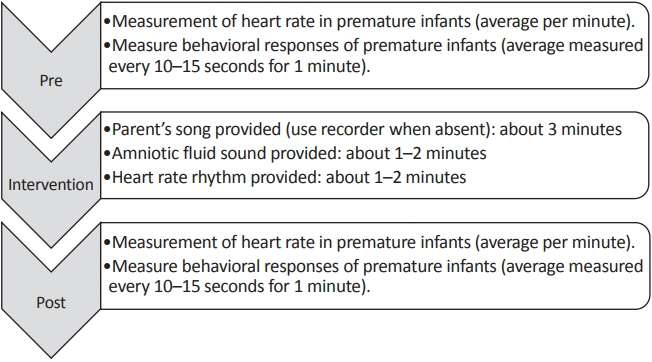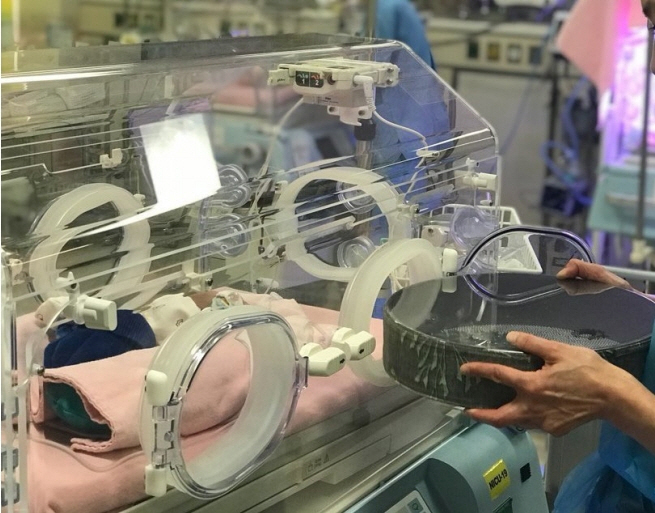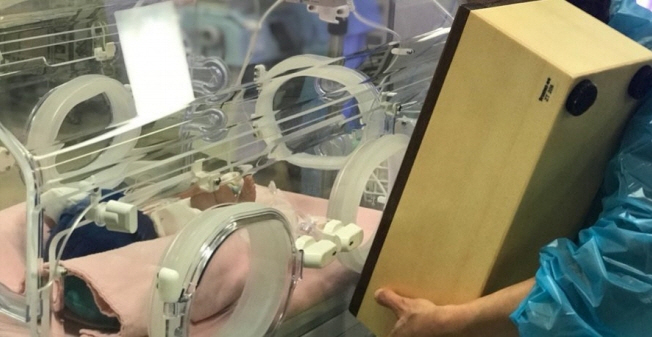Neonatal Med.
2020 Nov;27(4):174-180. 10.5385/nm.2020.27.4.174.
Effects of Music Intervention Techniques on Very-Low-Birth-Weight Infants in Neonatal Intensive Care Unit: A Preliminary Study
- Affiliations
-
- 1Department of Pediatrics, Ewha Womans University School of Medicine, Seoul, Korea
- 2Ewha Dodam Dodam Center , The Graduate School, Ewha Womans University, Seoul, Korea
- 3Department of Music Therapy, The Graduate School, Ewha Womans University, Seoul, Korea
- KMID: 2510822
- DOI: http://doi.org/10.5385/nm.2020.27.4.174
Abstract
- Purpose
The aim of this study was to evaluate the physiological and behavioral effects of auditory stimulation with their own parent’s voice on heart rate and sleep states of very-low-birth-weight infants (VLBWIs) in neonatal intensive care unit.
Methods
The data of 28 VLBWIs at the Ewha Womans University Mokdong Hospital between October 2016 and May 2017 was analyzed. They were exposed to sounds similar to those of mothers’ heartbeat they had heard in the uterus and their own parent’s voice. Heart rate was assessed as the physiological responses and sleep state of infants as behavioral response. The sleep states were categorized into six states. The music intervention program was provided twice a week.
Results
Twenty-eight babies with an average gestational age of 28 weeks (average birth weight of 1.09 kg) had undergone the sessions (average of 16 times) average of 16 times. During the initial period, there were no meaningful differences of the heart rates measured by the physiological functions before and after the sessions. However, as we move to the adaptive phase, the average heart rate was 156.96±12.22, and the pre-discharge was 149.11±12.01, which indicates meaningful differences (P<0.05). Infants’ behavioral function was statistically insignificant.
Conclusion
The music intervention techniques in the neonatal intensive care unit environment in Korea have provided positive influence to VLBWIs' physiological reactions. We were not able to come up with the relevant indicators during this phase of the study but we do plan to announce the future study results after indexing the observation results.
Figure
Reference
-
1. Kang IS, Kim YH. The effect of recorded mother’s voice on the body weight and physiological reactions of the premature infants. J Korean Biol Nurs Sci. 2011; 13:94–101.2. Yeum MK, Ahn YM, Seo HS, Jun YH. The effects of maternal heart sound on the weight, physiologic responses and behavioral states of premature infants. Child Health Nurs Res. 2010; 16:211–9.3. Crade M, Lovett S. Fetal response to sound stimulation: preliminary report exploring use of sound stimulation in routine obstetrical ultrasound examinations. J Ultrasound Med. 1988; 7:499–503.4. Lagercrantz H, Changeux JP. The emergence of human consciousness: from fetal to neonatal life. Pediatr Res. 2009; 65:255–60.5. American Academy of Pediatrics. Noise: a hazard for the fetus and newborn. Committee on Environmental Health. Pediatrics. 1997; 100:724–7.6. Loewy J, Stewart K, Dassler AM, Telsey A, Homel P. The effects of music therapy on vital signs, feeding, and sleep in premature infants. Pediatrics. 2013; 131:902–18.7. Caine J. The effects of music on the selected stress behaviors, weight, caloric and formula intake, and length of hospital stay of premature and low birth weight neonates in a newborn intensive care unit. J Music Ther. 1991; 28:180–92.8. Shoemark H. Infant-directed singing as a vehicle for regulation rehearsal in the medically fragile full-term infant. Aust J Music Ther. 2006; 17:54–63.9. Standley JM. A meta-analysis of the efficacy of music therapy for premature infants. J Pediatr Nurs. 2002; 17:107–13.10. Standley JM. The effect of music-reinforced nonnutritive sucking on feeding rate of premature infants. J Pediatr Nurs. 2003; 18:169–73.11. Keith DR, Russell K, Weaver BS. The effects of music listening on inconsolable crying in premature infants. J Music Ther. 2009; 46:191–203.12. Yoo KH. The effects of auditory and vestibular stimulation on stress hormones in preterm infants. J Korean Acad Fundam Nurs. 2004; 11:203–12.13. Collins SK, Kuck K. Music therapy in the neonatal intensive care unit. Neonatal Netw. 1991; 9:23–6.14. Burke M, Walsh J, Oehler J, Gingras J. Music therapy following suctioning: four case studies. Neonatal Netw. 1995; 14:41–9.15. Chou SJ, Choi SH. The effect of music therapy on the heart rate and behavioral state of premature infants. Korean J Child Health Nurs. 2006; 12:84–8.16. Haslbeck FB. Music therapy for premature infants and their parents: an integrative review. Nord J Music Ther. 2012; 21:203–26.17. Charpie M. Music therapy in the NICU a bridge between mother and baby. New York: Satchnote Press;2002.18. Loewy J, Hallan C, Friedman E, Martinez C. Sleep/sedation in children undergoing EEG testing: a comparison of chloral hydrate and music therapy. J Perianesth Nurs. 2005; 20:323–32.19. Loewy JV. Music therapy for hospitalized infants and their parents. In : Edwards J, editor. Music therapy and parent-infant bonding. Oxford: Oxford University Press;2011. p. 179–90.20. Arnon S, Shapsa A, Forman L, Regev R, Bauer S, Litmanovitz I, et al. Live music is beneficial to preterm infants in the neonatal intensive care unit environment. Birth. 2006; 33:131–6.21. Garunkstiene R, Buinauskiene J, Uloziene I, Markuniene E. Controlled trial of live versus recorded lullabies in preterm infants. Nord J Music Ther. 2014; 23:71–88.22. Lester BM, Tronick EZ. History and description of the Neonatal Intensive Care Unit Network Neurobehavioral Scale. Pediatrics. 2004; 113(3 Pt 2):634–40.23. Alipour Z, Eskandari N, Ahmari Tehran H, Eshagh Hossaini SK, Sangi S. Effects of music on physiological and behavioral responses of premature infants: a randomized controlled trial. Complement Ther Clin Pract. 2013; 19:128–32.24. Schlez A, Litmanovitz I, Bauer S, Dolfin T, Regev R, Arnon S. Combining kangaroo care and live harp music therapy in the neonatal intensive care unit setting. Isr Med Assoc J. 2011; 13:354–8.25. Dorn F, Wirth L, Gorbey S, Wege M, Zemlin M, Maier RF, et al. Influence of acoustic stimulation on the circadian and ultradian rhythm of premature infants. Chronobiol Int. 2014; 31:1062–74.
- Full Text Links
- Actions
-
Cited
- CITED
-
- Close
- Share
- Similar articles
-
- Effects of the 'Intervention - Mother's Song' on Physical Response and Behavioral State of Low-Birth Weight Infants in a Neonatal Intensive Care Unit
- Sequential Cases of Staphylococcal Scalded Skin Syndrome in Very Low Birth Weight Infants
- Clincial Study on Very Low Birth Weight Infants
- The Effects of Kangaroo Care on Anxiety and Confidence and Gratification of Mothering Role in Mothers of Low Birth Weight Infants
- Changes in Neonatal Epidemiology during the Last 3 Decades in Korea




